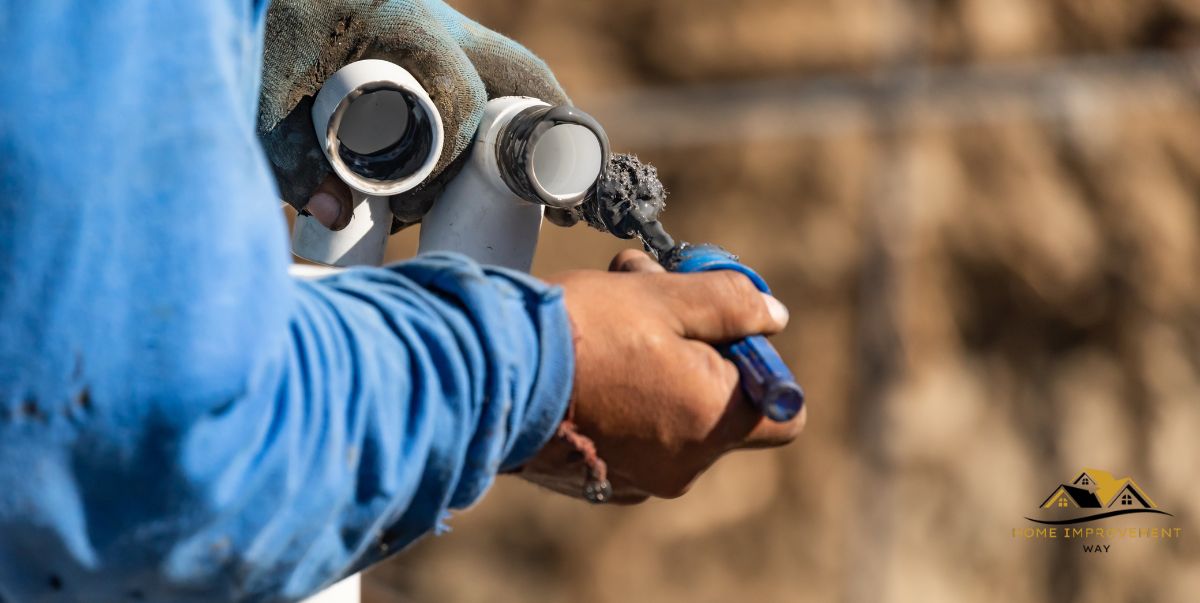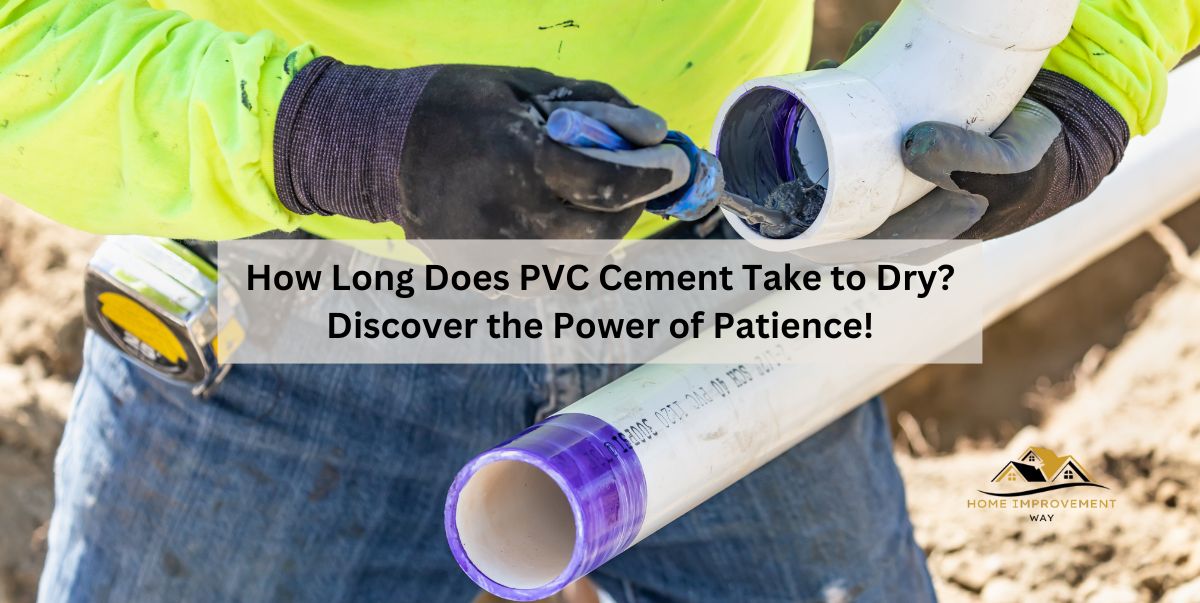PVC cement typically takes around 15 minutes to dry completely. When using PVC cement, it’s important to allow enough time for the adhesive to fully dry before handling or applying pressure to the joint.
Welcome to our guide on the drying time of PVC cement. Whether you’re working on a plumbing project or a DIY craft, understanding how long PVC cement takes to dry is crucial. We will provide you with all the necessary information and tips to help you achieve a strong and secure bond when using PVC cement.
We will discuss the factors that affect drying time, how to properly apply PVC cement, and the importance of allowing enough time for the adhesive to dry completely before handling or putting pressure on the joint. So, let’s dive in and learn more about the drying time of PVC cement.
Understanding Pvc Cement
PVC cement typically takes around 15-30 minutes to dry completely. It’s important to allow sufficient drying time for a strong and secure bond to form when working with PVC pipes and fittings.
PVC cement is a key component in working with PVC pipes and fittings. It is a type of adhesive specifically designed to bond PVC components together. Understanding how PVC cement works, its uses, and the different types available can help ensure successful DIY projects and plumbing repairs.
What Is Pvc Cement?
PVC cement, also known as solvent cement, is a specialized glue formulated to chemically bond PVC pipes and fittings. It consists of a mixture of solvents that dissolve the outer layer of PVC, creating a fusion when the two pieces are joined together. This fusion ensures a strong, leak-proof connection between the components.
Why Is Pvc Cement Used?
- PVC cement is primarily used in plumbing applications to connect PVC pipes and fittings.
- It is favored for its ability to create a permanent, watertight seal.
- By chemically bonding the PVC components, it eliminates the risk of leaks or separation.
- PVC cement is also preferred for its ease of use, as it requires no additional tools or equipment.
Different Types Of Pvc Cement
There are various types of PVC cement available, each designed for specific applications and pipe sizes. Some common types include:
| Type | Description |
|---|---|
| All-Purpose PVC Cement | A versatile option suitable for a wide range of pipe sizes and applications. |
| Low-VOC PVC Cement | An environmentally-friendly option with lower levels of volatile organic compounds (VOCs). |
| Quick-Drying PVC Cement | A fast-setting option that reduces drying time and allows for quicker assembly. |
| Heavy-Duty PVC Cement | A stronger adhesive designed for larger diameter pipes and industrial applications. |
Choosing the right type of PVC cement is essential for ensuring a secure and durable bond between PVC components. Always refer to the manufacturer’s instructions and select the appropriate cement for your specific project.

Drying Process Of Pvc Cement
When it comes to working with PVC pipes, using the right adhesive is crucial to ensure a strong and long-lasting bond. PVC cement is commonly used for joining pipes and fittings together, but many people wonder how long it takes for the cement to dry. In this blog post, we will explore the drying process of PVC cement and discuss the factors that can affect drying time.
Factors Affecting Drying Time
The drying time of PVC cement can vary depending on several factors. Here are some factors that can influence how quickly the cement sets:
- Temperature: PVC cement dries faster in higher temperatures, while low temperatures can extend the drying time.
- Humidity: High humidity levels can slow down the drying process, while low humidity can speed it up.
- Type of PVC cement: Different types of PVC cement have varying drying characteristics. Some cements are formulated for fast drying, while others require more time to set.
- Thickness of the joint: Thicker applications of PVC cement may take longer to dry compared to thin layers.
By understanding these factors, you can better estimate the drying time for your specific PVC cement project.
Drying Time For Different Pvc Cement Types
The drying time for PVC cement can also vary depending on the type of cement used. Here’s a general guideline for drying times of common PVC cement types:
| PVC Cement Type | Drying Time |
|---|---|
| Regular PVC Cement | About 15 to 30 minutes |
| Fast-Setting PVC Cement | About 10 to 15 minutes |
| Medium-Setting PVC Cement | About 20 to 30 minutes |
| Solvent-Free PVC Cement | About 30 to 45 minutes |
Keep in mind that these drying times are approximate and can vary depending on the environmental conditions and the specific brand or manufacturer of the PVC cement.
In conclusion, the drying time of PVC cement is influenced by factors such as temperature, humidity, type of cement, and the thickness of the joint. Understanding these factors and using the appropriate PVC cement for your project will help you achieve a strong and reliable bond.
Tips For Faster Drying
When it comes to PVC cement, drying time can vary depending on several factors. However, there are some handy tips you can follow to speed up the drying process. By implementing these techniques, you can ensure that your PVC joints are ready for use in no time.
Using A Primer
One effective method to accelerate the drying of PVC cement is to use a primer before applying the cement. A primer is a substance that prepares the surface of the PVC pipe and fittings for better adhesion of the cement. By applying a thin coat of primer to the areas where you plan to apply the cement, you can enhance the bond and facilitate faster drying.
Applying Thin Layers
Another strategy to expedite the drying time of PVC cement is to apply thin layers instead of thick ones. When you apply a thick layer of cement, it takes longer to dry and cure. On the other hand, thin layers dry faster and allow you to move on to the next step. Ensure that you spread the cement evenly and thinly on the surfaces you are joining to promote quicker drying.
Optimal Temperature And Humidity
The temperature and humidity in your working environment also play a crucial role in the drying time of PVC cement. It is best to work in a room that has an optimal temperature range of 60°F to 100°F (15°C to 37°C). Additionally, a humidity level of around 50% is considered ideal. These conditions contribute to faster evaporation and drying of the cement. If the temperature and humidity are outside these ranges, the drying time may be significantly longer.
By following these tips, you can shorten the drying time of PVC cement and expedite your project. Remember to use a primer, apply thin layers, and work in the right temperature and humidity conditions. With these strategies, you’ll have your PVC joints ready for action in less time.
Importance Of Waiting For Proper Drying
When working with PVC (polyvinyl chloride) pipes and fittings, using PVC cement is essential for achieving a strong and reliable bond. PVC cement acts as a solvent, softening the surfaces of the pipe and fitting, allowing them to fuse together. However, it’s crucial to wait for proper drying before using the connected pipes. In this article, we will explore the importance of waiting for proper drying and the implications of not doing so.
1. Adhesion And Strength
Allowing the PVC cement to dry completely ensures that the pipes and fittings are securely bonded. The drying process forms a durable and strong connection, ensuring the joined components stay together under pressure and load. Rushing the drying time may compromise the adhesion and strength of the bond, leading to potential failures and leaks.
2. Avoiding Failures And Leaks
Properly dried PVC cement creates a tight seal, preventing any potential leaks. Failing to wait for the recommended drying time may result in a weak or incomplete bond, allowing water or other fluids to escape through the connection. This can lead to costly repairs, damage to property, and disruption to everyday activities. Waiting for the PVC cement to dry is a small investment in time that ensures long-term reliability.
Here are some additional tips and precautions to keep in mind:
- Follow the manufacturer’s instructions for the specific PVC cement you are using, as drying times can vary.
- Ensure that the PVC surface is clean, dry, and free from any debris or contaminants before applying the cement.
- Apply the PVC cement evenly and generously to both the pipe and fitting.
- Join the pipe and fitting together immediately after applying the cement, as it starts to dry quickly.
- Avoid any movements or disturbances to the pipe and fitting during the drying process to maintain a strong bond.
- Allow sufficient drying time as specified by the manufacturer before subjecting the joints to pressure or stress.
By patiently waiting for PVC cement to dry, you’re ensuring the adhesion, strength, and performance of your PVC pipe connections. Taking this extra step will help you avoid failures, leaks, and the subsequent inconvenience and expense they can cause. Remember, patience and attention to detail are key when working with PVC cement.
Common Mistakes And Troubleshooting
When it comes to working with PVC cement, it’s important to be patient and follow the proper steps for optimal results. Rushing the drying process or neglecting to evaluate and address inadequate drying are common mistakes that can lead to issues down the line. In this section, we’ll explore these mistakes and provide troubleshooting tips to help you ensure your PVC cement dries properly.
Hastiness And Rushing The Process
Rushing the drying process is a common mistake that many DIY enthusiasts make. It’s understandable – we all want to get the job done quickly. However, applying pressure or handling PVC joints before the cement is fully dried can lead to leaks and weak bondings.
- Don’t rush: Allow sufficient time for the PVC cement to dry completely. The drying time can vary depending on factors such as temperature and humidity, but typically it takes around 15 to 30 minutes. Take into account the manufacturer’s instructions to ensure proper drying.
- Avoid unnecessary movement: Just because the cement is dry to the touch doesn’t mean it has fully cured. Avoid unnecessary movement or handling of the joints for at least 30 minutes to give the adhesive enough time to bond securely.
Evaluating And Fixing Inadequate Drying
Even if you follow the recommended drying time, there may be instances where the PVC cement doesn’t dry properly. Inadequate drying can result in weak bondings and potential leaks. Here are some steps to evaluate and fix inadequate drying:
- Inspect the joint: Carefully examine the PVC joint for any signs of inadequate drying, such as sticky or soft areas.
- Re-drying the joint: If you find any areas that haven’t dried properly, cover the joint with a plastic bag or wrap and allow it to cure for an additional 24 hours.
- Reapply the cement: If the joint still doesn’t dry after re-drying, you may need to remove the PVC joint, clean it thoroughly, and reapply fresh PVC cement. Ensure the joint is completely dry before applying the new adhesive.
By taking the time to evaluate and address inadequate drying, you can prevent potential issues and ensure a strong and durable PVC joint.
Conclusion
The drying time of PVC cement largely depends on multiple factors, such as temperature, humidity, and the specific type of cement used. It is important to follow the manufacturer’s instructions to ensure a proper bond. Generally, PVC cement can take anywhere from a few minutes to several hours to fully dry.
Proper drying is crucial for a secure and long-lasting bond, so patience and adherence to instructions are key. Remember to handle the joint with care until the cement has completely cured.


